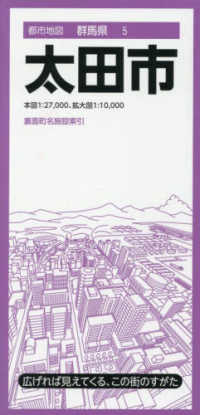- ホーム
- > 洋書
- > 英文書
- > Science / Mathematics
Full Description
Learn all the basics about pumps in one place. Clearly written by an ace consultant, this manual for operators and specialists in the petroleum industry gives readers a concise overview of the mechanics of various pumps and reviews the specifications to be considered before a pump is purchased and installed. The straight-forward text explains pump hydraulics without need of involved mathematics and provides expert advice on installing centrifugal pumps in process plants. The book also emphasizes the mechanical aspects of pumps as it delves into misunderstandings and oversights on bearings, seals, impeller trimming, lubricant application, lubricant types, and much more.
Contents
1 Principles of Process Pumps. Pump performance: Head and Flow. Operation at zero flow. Impellers and rotors. The meaning of specific speed. Process pump types. Process pump mechanical response to flow changes. Recirculation and cavitation. The importance of suction specific speed. What we have learned. 2 Pump Types and Selection. Why insist on better pumps. ANSI and ISO vs. API pumps. What we have learned. 3 Foundations and Base Plates. Securing pumps in place with one exception. Why not to install pump sets in the as-shipped condition. Conventional vs. pre-filled base plate installations. Epoxy pre-filled base plates. How to proceed if there is no access to specialist firms. What we have learned. 4 Piping and Gaskets. Pipe installation and support. Sliding supports and installation sequence deserve special attention. Monitoring pipe stress while bolting up. Flange leakage. What to do prior to gasket insertion. Spiral wound and kammprofile gaskets. Pipe, hydraulic tubing or flexible connections. Gusseting. Concentric vs. eccentric reducers. Vibration problems in piping. What we have learned. 5 Rolling Element Bearings. Bearing selection overview and windage as a design problem. Radial vs. axial (thrust) bearings. Oil levels, multiple bearings, and different bearing orientations. Upgrading and retrofit opportunities. Bearing cages. Bearing preload and clearance effects. Bearing dimensions and mounting tolerances. What we have learned. 6 Lubricant Application and Cooling Considerations. Lubricant level and oil application. Issues with oil rings. Pressure and temperature balance in bearing housings. Cooling not needed on pumps with rolling element bearings. Oil delivery by constant level lubricators. Black oil. Lube application as oil mist (oil fog). Desiccant breathers and expansion chambers. What we have learned. 7 Lubricant Types and Key Properties. Lubricant viscosities. When and why high film-strength synthetic lubricants are used. Lubricants for oil mist systems. What we have learned. 8 Bearing Housing Protection and Cost-Justification. Non-contacting bearing protector seals. Contacting bearing protector seals. How venting and housing pressurization affect bearing protector seal performance. Cost justification overview. Advanced bearing housing (bearing protector) seal summary. What we have learned. 9 Mechanical Sealing Options for Long Life. Still using packing? General overview of mechanical seals. All flush plans have advantages and disadvantages. Always obtain the full picture. Seal chamber pumping ring (circulating device) technologies. Lessons to apply to many services. What we have learned. 10 Pump Operation. Starting centrifugal pumps. Surveillance of pump operation. Centrifugal pump shutdown. What we have learned. 11 Impeller Modifications and Pump Maintenance. Maintenance essentials. Superior maintenance requires upgrading. Impeller upgrading with inducers. Distance from impeller tips to stationary internal casing components. Impeller trimmings. Impeller wear rings. Vane tip overfiling and underfiling. What we have learned. 12 Lubrication Storage and Management. How bad is water contamination? Avoid solids contamination. Avoid questionable storage and transfer practices. Periodic audits. What we have learned. 13 Pump Condition Monitoring. Vibration and its effect on bearing life. Monitoring methods differ. Vibration acceptance limits. Causes of excessive vibration. Rotor balancing. What we have learned. 14 Drivers, Couplings, and Alignment. Driver selection. Coupling selection and installation. Installation and removal. Alignment and quality criteria. Consequences of misalignment. Thermal rise and predefinition of growth. What we have learned. 15 Fits, Dimensions, and Related Misunderstandings. Low incremental cost of better pumps. Pump pedestals and bearing housings should not be water-cooled. Summary of bearing-related issues. Constant level lubricators. Bearing housing protector seals( bearing isolators ). Motor lubrication summary. Mechanical seal issues. Hydraulic issues. Impeller hydraulics. Mechanical improvement or upgrade options. Process pump repair dimensions. What we have learned. 16 Failure Statistics and Successful Failure Analysis. Mean time between failures and repair cost calculations. Performing your own projected MTBF calculations. Older pumps vs. newer pumps. Reliability reviews start before purchase. Structured failure analysis strategies solve problems. The FRETT approach to eradicating repeat failures of pumps. What we have learned. Index.








